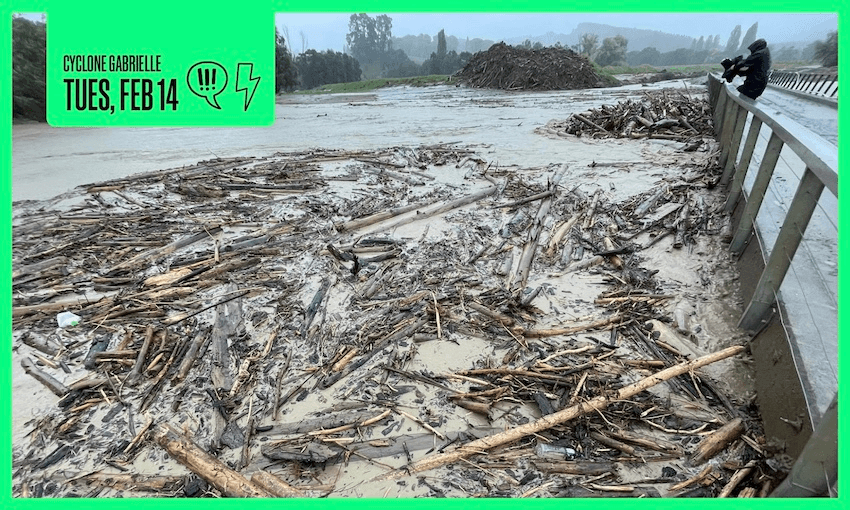Gisborne has been brutally hit by Cyclone Gabrielle, but the response by both its officials and tangata whenua has been admirable.
Tairāwhiti has been ravaged by a natural disaster once again. As well as feeling the full force of Cyclone Gabrielle, a magnitude 4.4 earthquake shook the region on Monday night. But the cyclone has done most of the damage. Speaking to RNZ, MetService’s Lisa Murray said Cyclone Gabrielle pelted Gisborne with 400mm of rain in 24 hours. The Gisborne District Council (GDC) puts that figure even higher, at 450mm. Gisborne’s average rainfall for the entire month of February is usually just 64.51mm.
The extreme rainfall, combined with high tide just before 1am, caused widespread flooding throughout the night. Riverside properties across Gisborne were particularly at risk, many being evacuated. The GDC records water levels of Gisborne’s rivers at 32 sites across the region, and last week, the average height across all rivers was below 5m. Since Gabrielle hit, the GDC has recorded river levels of 7m-10m at seven sites and 11m-14m at six sites. Unfortunately, Tairāwhiti is not out of the woods yet, with another 50-80mm of rain projected on Tuesday.
As of Tuesday afternoon, February 14, much of the Gisborne and Wairoa regions were still without cellphone services, eftpos and landline coverage due to the communications cable being severed at 2.15am that morning, according to the region’s Civil Defence authorities.
Prime minister Chris Hipkins noted that communicating with the region is currently “difficult”, so the situation there is yet to be fully assessed. Alongside service issues, the wider area is also without power, with providers Eastland Network and Transpower working to rebuild the grid. Also in short supply is water, with damage to the pipes between the dams and the treatment plant. Civil Defence warned that there was no quick water infrastructure fix, but “If we work together and everyone does their part we can get through this as a community.” Officials have urged residents to “restrict water use to emergency use only”.
Road access into and out of Tairāwhiti has also been severed by the wild weather. SH2 northbound and southbound, as well as SH35 northbound, are closed. “We are totally cut off – all our roads are closed in and out of the region… we are really isolated,” Mayor Rehette Stoltz said to NZME. Residents are being told to stay home if it is safe to do so or evacuate to a shelter if necessary. Even essential amenities like supermarkets and gas stations are closed because critical services – like power and eftpos – are disconnected.
Although chaos has descended upon Tairāwhiti over the last few days, the communication from the top appears to have been better than what Auckland experienced during January’s flooding. The GDC and, in particular, Tairāwhiti Civil Defence have done an admirable job. But another group that has worked alongside the council and emergency responders has been the local Māori radio stations.
Three Māori radio stations have been a part of Tairāwhiti’s official cyclone communication strategy: Radio Ngāti Porou, Turanga FM and Uawa FM. The stations’ airwaves and social media pages have been a source of credible information within the disaster-stricken region. On the Radio Ngāti Porou Facebook page, several people thanked the station for keeping people informed. The station committed to broadcasting 24 hours a day during the cyclone with the latest information – interrupted only by conditions outside of their control, like power outages. Mainstream radio stations such as More FM and RNZ have also been a lesser part of Gisborne’s official communication strategy. However, they have not featured as prominently and promptly as the Māori stations. The mainstream stations also have considerably more resources and staff than the Māori stations, putting into perspective the Māori efforts – particularly Radio Ngāti Porou’s commitment to a 24-hour broadcast.
As well as the Māori radio station’s contribution to getting out official information from the GDC and Tairāwhiti Civil Defence, local marae have opened their doors to those in need. The GDC website lists 30 welfare centres across the region for those needing assistance during the cyclone – a list dominated by marae. Sixteen of the 30 welfare centres are located at marae. Unlike the GDC and Civil Defence, these 16 marae have no legal obligation to help out, but they have a tikanga duty to assist. Manaakitanga dictates that tangata whenua (the marae) must extend their resources to their manuhiri (the locals in danger), which the marae have graciously done. Tairāwhiti’s marae and Māori radio stations have shone brightly through Gisborne’s blackout.
Follow The Spinoff’s Live Updates over the coming days for more Cyclone Gabrielle coverage, including the latest from Gisborne.





